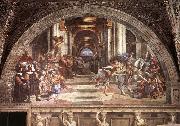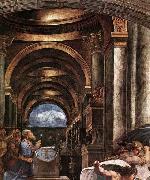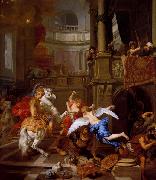Wholesale Oil Painting No Minimum |
|||||||||||
|
|
|||||||||||

|
|||||||||||
|
|
|
||||||||
RAFFAELLO SanzioItalian High Renaissance Painter, 1483-1520 Italian painter and architect. As a member of Perugino's workshop, he established his mastery by 17 and began receiving important commissions. In 1504 he moved to Florence, where he executed many of his famous Madonnas; his unity of composition and suppression of inessentials is evident in The Madonna of the Goldfinch (c. 1506). Though influenced by Leonardo da Vinci's chiaroscuro and sfumato, his figure types were his own creation, with round, gentle faces that reveal human sentiments raised to a sublime serenity. In 1508 he was summoned to Rome to decorate a suite of papal chambers in the Vatican. The frescoes in the Stanza della Segnatura are probably his greatest work; the most famous, The School of Athens (1510 C 11), is a complex and magnificently ordered allegory of secular knowledge showing Greek philosophers in an architectural setting. The Madonnas he painted in Rome show him turning away from his earlier work's serenity to emphasize movement and grandeur, partly under Michelangelo's High Renaissance influence. The Sistine Madonna (1513) shows the richness of colour and new boldness of compositional invention typical of his Roman period. He became the most important portraitist in Rome, designed 10 large tapestries to hang in the Sistine Chapel, designed a church and a chapel, assumed the direction of work on St. Peter's Basilica at the death of Donato Bramante, |
||||||||
|
|
||||||||
The Expulsion of Heliodorus from the Temple
The Expulsion of Heliodorus from the Temple Painting ID:: 51243 |
1511-12
Fresco, width at the base 750 cm 1511-12 Fresco, width at the base 750 cm |
|||||||
|
|
||||||||
RAFFAELLO SanzioItalian High Renaissance Painter, 1483-1520 Italian painter and architect. As a member of Perugino's workshop, he established his mastery by 17 and began receiving important commissions. In 1504 he moved to Florence, where he executed many of his famous Madonnas; his unity of composition and suppression of inessentials is evident in The Madonna of the Goldfinch (c. 1506). Though influenced by Leonardo da Vinci's chiaroscuro and sfumato, his figure types were his own creation, with round, gentle faces that reveal human sentiments raised to a sublime serenity. In 1508 he was summoned to Rome to decorate a suite of papal chambers in the Vatican. The frescoes in the Stanza della Segnatura are probably his greatest work; the most famous, The School of Athens (1510 C 11), is a complex and magnificently ordered allegory of secular knowledge showing Greek philosophers in an architectural setting. The Madonnas he painted in Rome show him turning away from his earlier work's serenity to emphasize movement and grandeur, partly under Michelangelo's High Renaissance influence. The Sistine Madonna (1513) shows the richness of colour and new boldness of compositional invention typical of his Roman period. He became the most important portraitist in Rome, designed 10 large tapestries to hang in the Sistine Chapel, designed a church and a chapel, assumed the direction of work on St. Peter's Basilica at the death of Donato Bramante, |
||||||||
|
|
||||||||
|
|
The Expulsion of Heliodorus from the Temple
The Expulsion of Heliodorus from the Temple Painting ID:: 63793 |
1511-12 Fresco, width of detail: 230 cm Stanza di Eliodoro, Palazzi Pontifici, Vatican In the centre, the expanse of the wide nave, illuminated by the reflections of light in the vault, is a more effective space-determining motif than the large patches of blue sky which appeared through the coffered ceiling in the School of Athens.Artist:RAFFAELLO Sanzio Title: The Expulsion of Heliodorus from the Temple (detail) Painted in 1501-1550 , Italian - - painting : religious 1511-12 Fresco, width of detail: 230 cm Stanza di Eliodoro, Palazzi Pontifici, Vatican In the centre, the expanse of the wide nave, illuminated by the reflections of light in the vault, is a more effective space-determining motif than the large patches of blue sky which appeared through the coffered ceiling in the School of Athens.Artist:RAFFAELLO Sanzio Title: The Expulsion of Heliodorus from the Temple (detail) Painted in 1501-1550 , Italian - - painting : religious |
||||||
|
|
||||||||
Gerard de LairesseGerard or Gerard de Lairesse (11 September 1640 or 1641 - June 1711) was a Dutch Golden Age painter and art theorist. Lairesse was born in Liege. His broad range of talent included music, poetry, and the theatre. He was perhaps the most celebrated Dutch painter in the period following the death of Rembrandt. His treatises on painting and drawing, Grondlegginge der teekenkonst (1701) and Groot Schilderboek (1707), were highly influential on 18th-Century painters like Jacob de Wit. Students of De Lairesse included the painter Jan van Mieris. He died in Amsterdam. |
||||||||
|
|
||||||||
|
|
The Expulsion of Heliodorus From The Temple
The Expulsion of Heliodorus From The Temple Painting ID:: 81014 |
Date 1674(1674)
Medium English: Oil on canvas
Dimensions 204 x 193 cm (80.3 x 76 in)
cjr Date 1674(1674) Medium English: Oil on canvas Dimensions 204 x 193 cm (80.3 x 76 in) cjr |
||||||
|
|
||||||||
|
Gerard de Lairesse Gerard or Gerard de Lairesse (11 September 1640 or 1641 - June 1711) was a Dutch Golden Age painter and art theorist. Lairesse was born in Liege. His broad range of talent included music, poetry, and the theatre. He was perhaps the most celebrated Dutch painter in the period following the death of Rembrandt. His treatises on painting and drawing, Grondlegginge der teekenkonst (1701) and Groot Schilderboek (1707), were highly influential on 18th-Century painters like Jacob de Wit. Students of De Lairesse included the painter Jan van Mieris. He died in Amsterdam. The Expulsion of Heliodorus From The Temple Date 1674(1674) Medium English: Oil on canvas Dimensions 204 x 193 cm (80.3 x 76 in) cjr |
||||||||
|
|
||||||||
|
Prev Next
|
||||||||
|
|
||||||||
|
Related Paintings to Gerard de Lairesse :. |
||||||||
|
|
||||||||
|
CONTACT US |



